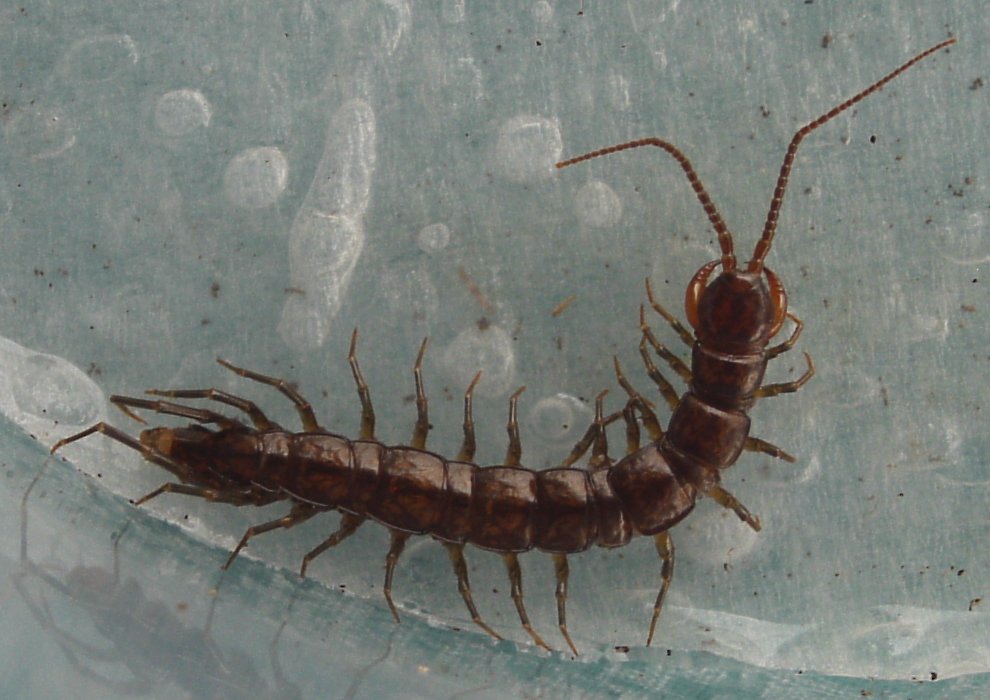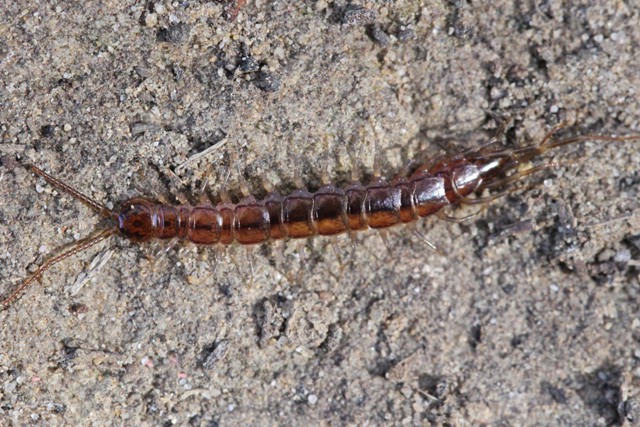Key to Australian Freshwater and Terrestrial Invertebrates
Phylum Arthropoda
Subphylum Myriapoda
Class Chilopoda
Order Lithobiomorpha
Common names: stone centipedes, lithobiomorphs
Overview
The Lithobiomorpha are short, compact centipedes that range from 4�40 mm in size. They have 15 pairs of legs, 18 body segments. They exhibit strong tergite heteronomy as some tergites are much longer than other segments. The front pairs of legs are short and they increase in length towards the back. The final two pairs are longest and are used in mating and capture of prey. The spiracles are paired and can be found laterally. The body and head are dorsoventrally flattened, enabling the animal to invade narrow crevices in search of food. The head is 'heart-shaped' with a distinctive ridge along each side. Members of this order have filiform antennae of 13 to 100 segments, and teeth and accessory setae on the mandibles. The group has lost the compound eye and most species have ocelli which are present in small lateral clusters numbering between one and 30 ocelli, although there are some blind species. Below the eyes on each side is a sensory organ called the T�m�sv�ry organ. Taxonomically significant distal spines may be present on the anal legs of both sexes. A terminal claw, which is generally divided into five digits, is present. Other characteristics unique to the Lithobiomorpha include enlarged and modified podomeres on the tenacipeds of many male lithobiids and female gonopods have a claw and two or more spurs.
Distribution and diversity
The Lithobiomorpha is a large and diverse cosmopolitan order comprised of two families that are distinguished by the presence of setae alone on the legs (Henicopidae) or spines/spurs plus setae (Lithobiidae). There are 95 genera, and around 1500 described species, with an estimated global fauna of greater than 2000 species. There are currently 20 lithobiomorphs described in Australia. Australian Henicopidae stone centipedes have a distinctly Gondwanic distribution and are remarkably similar to closely related species of Henicopidae found in New Zealand, Argentina and Chile. In Australia, the species of Lithobius are believed to have been introduced, while the Australian native species Lamyctes emarginatus is an invader in temperate areas of Europe, North America, and Greenland.
Life cycle
Male lithobiids place spermatophores on webs which are then removed by the females. The females store the sperm in the receptaculum seminis where it is probably maintained by glandular secretions. Many species of Lithobiomorpha reproduce parthenogenetically. Eggs of Lithobiomorpha are laid one by one at intervals of a few days. Each egg is carried for around 14 days on the hind legs. During this time it is coated with a mucoid secretion and subsequently covered with soil particles, which is an example of primitive brood protection. In this way it is made nearly indistinguishable from the soil and protected against fungus before being abandoned by the female. One egg is laid over several days and thus, the reproductive potential is small at around 25 eggs per year. Lithobiids have anamorphic development, with 5 larval instars. Hatchlings emerge with 6-8 pairs of legs and add addition pairs with each moult. They display slow development, reaching sexual maturity around two years and have an average life span of 4-7 years.
Feeding
Stone centipedes capture prey with their poison claws, and cut up food with its mandibles. The stout poison claws are adapted for dealing with prey in the confined spaces. Some species are regarded as ambush predators, rather than hunters, and cannibalism is common. They have a wide variety of prey items including soft-bodied arthropods, worms, molluscs, spiders and nematodes.
Ecology
The Lithobiomorpha is a large, diverse order that occupies numerous habitats including temperate forest and woodland, forest tundra, arid zones and caves or larval flows. Some stone centipedes display a high resistance to hunger and cold, but a low resistance to water loss, while others have adaptations to living in arid regions, such as a reduction in the number and size of coxal pores to minimize water-loss. The Lithobiomorpha also has examples of short-range endemism due to low dispersal power of troglobitic species occurring in caves and cavities above the groundwater.








